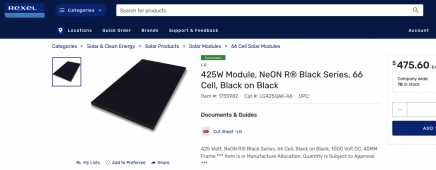Hedges
I See Electromagnetic Fields!
- Joined
- Mar 28, 2020
- Messages
- 20,695
Do you agree with the claim in that article that keeping DC voltages under 80VDC is one way to avoid any concern with arc faults?
Never say never, but it should reduce it.
Do you agree with the claim in that article that keeping DC voltages under 80VDC is one way to avoid any concern with arc faults?
The charge controller doesn't have that integration. It's in a separate module, MPPT Disconnect RS. That alone retails in the $700 range.I thought the Schneider SCC can detect both arch and ground faults and integrate with the Schneider RSD solution that then is integrated with Tigo. I may be talking nonsense but I believe that is what I read a month ago on the solution.

True, but the ability to drop the module voltage is also useful for arc fault protection, hence the value of integrating ground fault and arc fault into the RSD. I just think it is silly that the charge controller can't integrate that functionality for much less than the $700 Schneider charges for the MPPT-RSD.RSD is for the safety of firemen.


I was a bit sticker shocked at the RSD but after installing mine and having a look inside there is a bunch of stuff going on and it would be difficult to duplicate all the functionality and level of integration at the price point.True, but the ability to drop the module voltage is also useful for arc fault protection, hence the value of integrating ground fault and arc fault into the RSD. I just think it is silly that the charge controller can't integrate that functionality for much less than the $700 Schneider charges for the MPPT-RSD.
So this is awesome. Confirmation that the RSD actually works well for ground/arch. Quick question, with remote switch/button this will shutdown both the panels and inverter?I was a bit sticker shocked at the RSD but after installing mine and having a look inside there is a bunch of stuff going on and it would be difficult to duplicate all the functionality and level of integration at the price point.
My only problem with the RSD is that I can't seem to assign a unique Xanbus ID to mine, but both show up just fine in Insight.
The remote initiator shuts down everything. The local disconnect just breaks connection to the PV.So this is awesome. Confirmation that the RSD actually works well for ground/arch. Quick question, with remote switch/button this will shutdown both the panels and inverter?

 www.tigoenergy.com
www.tigoenergy.com

 www.tigoenergy.com
www.tigoenergy.com
Aren't they essentially resistors acting as a voltage divider that shunt the panel? That would limit the maximum input voltage to ensure code-compliant output voltage.They seem to be saying more Imp current is allowed, up to 20A, but not more Vmp. Wonder why, since Voc ought to be the limit.
Or extend the shed overhang by a foot or so...Looked at the Q.PEAK DUO XL-G10.3 / BFG 480 watt, but don't have room for them on the shop roof. (87" - too long to fit under the existing)
Plan "B": collecting quotes for 16 of these, as they are 75" long, and thus will overhang the roof edge only 2"
Might want to keep the old AO Smith as a backup/storage tank in series with the heat pump water heater. "They don't make them like they used to." Just add the isolation valves to be able to take either one out of service easily.The ancient AO Smith still works perfectly, but "time and technology march on"
Very conflicted about replacing a working water heater w/ no moving parts, reliable as an anvil, w/ new weird science.Might want to keep the old AO Smith
Also replacing the 17 year old AO Smith electric water heater (5kw load) with a
"Heat pump" water heater.
The ancient AO Smith still works perfectly, but "time and technology march on"


